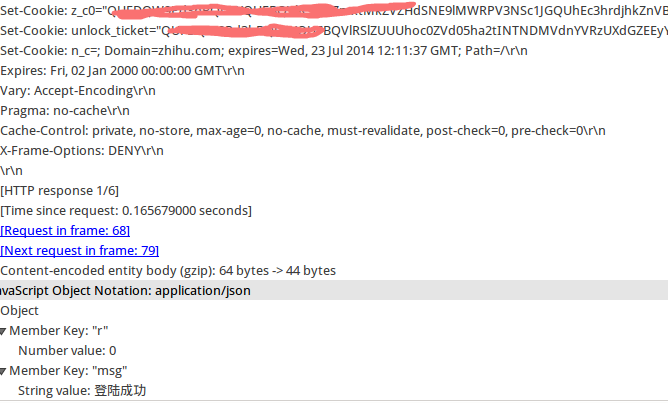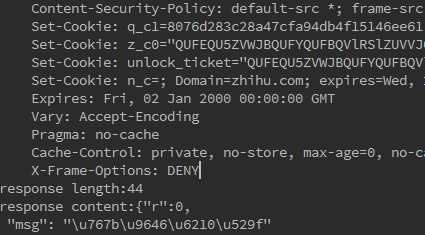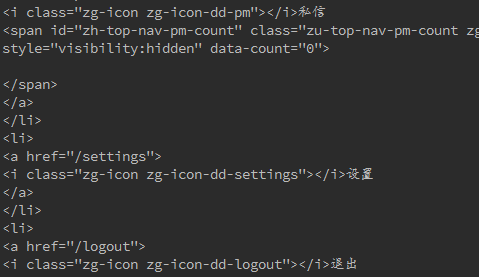HttpClient4.4 登录知乎(详细过程)
引言
HttpClient是java语言下一个支持http协议的客户端编程工具包,它实现了HTTP协议的所有方法,但是不支持JS渲染。我们在做一些小玩意时,有可能需要登录某些网站获取信息,那么HttpClient就是你的好帮手,废话不多说,进入实战。
一 登录的实际意义
在HTTP横行的今天,我们每天都要登录一些网站,那么登录的意义是什么呢?首先要对cookie要有一定了解。cookie是存放在本地的一些小文件,它由服务器发送命令,浏览器在本地读写。当访问某些网站的时候,浏览器会检查是否有所浏览网站的cookie信息,如果有则在发送访问请求的时候携带上这些内容,服务器可以读取到浏览器发送请求中的cookie信息,在回应请求时可以再写cookie信息。cookie信息包括键值,内容,过期时间,所属网站。
说到这里cookie差不多讲完了,那么登录到底是怎么回事?登录就是服务器向你的浏览器写cookie,如果仅仅是在你的计算机上写cookie,那么别有用心的人伪造一个cookie也有机会登录网站,所以服务器会在内存中保留一份相同的信息,这个过程叫做session会话。如果你在网站点击退出按钮,服务器会把内存中的cookie清除掉,同时清除浏览器中有关登录的cookie。知道了这些,我们就可以上手了。
二 找到登录关键cookie
这里我们可以用wireshark来抓包分析一下。打开知乎首页,打开wireshark,开始监听端口,输入用户名和密码,点击登录,查看wireshark抓到的包。截图如下:




第一张图是浏览器post提交数据。
第二张图是提交的信息,包括_xsrf,password,remember_me,email,注意,提交的信息中包括cookie,_xsrf可以从知乎首页中获取。
第三张图是服务器返回的信息,注意它的状态是200,说明是成功的。
第四章图是服务器返回的数据,注意它有三条cookie设置,以及带有一个登录成功与否的信息。
通过上边的步骤我们能知道什么呢?首先,发送登录请求的时候带有的cookie,以及post数据的格式,其次我们能拿到登录用cookie信息(第四张图)。
三 使用HttpClient构造登录信息
HttpClient是怎样模拟浏览器的呢?首先需要建立一个HttpClient,这个HttpClient是用来模拟一个浏览器。其次构造一个post请求,添加post数据信息以及cookie。详细代码如下:
import org.apache.http.*;
import org.apache.http.client.CookieStore;
import org.apache.http.client.config.CookieSpecs;
import org.apache.http.client.config.RequestConfig;
import org.apache.http.client.entity.UrlEncodedFormEntity;
import org.apache.http.client.methods.CloseableHttpResponse;
import org.apache.http.client.methods.HttpGet;
import org.apache.http.client.methods.HttpPost;
import org.apache.http.client.protocol.HttpClientContext;
import org.apache.http.config.Lookup;
import org.apache.http.config.RegistryBuilder;
import org.apache.http.cookie.CookieSpecProvider;
import org.apache.http.impl.client.BasicCookieStore;
import org.apache.http.impl.client.CloseableHttpClient;
import org.apache.http.impl.client.HttpClients;
import org.apache.http.impl.cookie.BasicClientCookie;
import org.apache.http.impl.cookie.DefaultCookieSpecProvider;
import org.apache.http.message.BasicNameValuePair;
import org.apache.http.util.EntityUtils;
import java.io.IOException;
import java.util.HashMap;
import java.util.LinkedList;
import java.util.List;
import java.util.Map;
/**
* Created by gavin on 15-7-23.
*/
public class HttpClientTest {
public static void main(String[] args)
{
//创建一个HttpClient
RequestConfig requestConfig = RequestConfig.custom().setCookieSpec(CookieSpecs.STANDARD_STRICT).build();
CloseableHttpClient httpClient = HttpClients.custom().setDefaultRequestConfig(requestConfig).build();
try {
//创建一个get请求用来接收_xsrf信息
HttpGet get = new HttpGet("http://www.zhihu.com/");
//获取_xsrf
CloseableHttpResponse response = httpClient.execute(get,context);
setCookie(response);
String responseHtml = EntityUtils.toString(response.getEntity());
String xsrfValue = responseHtml.split("<input type=\"hidden\" name=\"_xsrf\" value=\"")[1].split("\"/>")[0];
System.out.println("xsrfValue:" + xsrfValue);
response.close();
//构造post数据
List<NameValuePair> valuePairs = new LinkedList<NameValuePair>();
valuePairs.add(new BasicNameValuePair("_xsrf", xsrfValue));
valuePairs.add(new BasicNameValuePair("email", "xxxx@xxx.com"));
valuePairs.add(new BasicNameValuePair("password", "xxxxx"));
valuePairs.add(new BasicNameValuePair("remember_me", "true"));
UrlEncodedFormEntity entity = new UrlEncodedFormEntity(valuePairs, Consts.UTF_8);
//创建一个post请求
HttpPost post = new HttpPost("http://www.zhihu.com/login/email");
post.setHeader("Cookie", " cap_id=\"YjA5MjE0YzYyNGQ2NDY5NWJhMmFhN2YyY2EwODIwZjQ=|1437610072|e7cc307c0d2fe2ee84fd3ceb7f83d298156e37e0\"; ");
//注入post数据
post.setEntity(entity);
HttpResponse httpResponse = httpClient.execute(post);
//打印登录是否成功信息
printResponse(httpResponse);
//构造一个get请求,用来测试登录cookie是否拿到
HttpGet g = new HttpGet("http://www.zhihu.com/question/following");
//得到post请求返回的cookie信息
String c = setCookie(httpResponse);
//将cookie注入到get请求头当中
g.setHeader("Cookie",c);
CloseableHttpResponse r = httpClient.execute(g);
String content = EntityUtils.toString(r.getEntity());
System.out.println(content);
r.close();
} catch (IOException e) {
e.printStackTrace();
} finally {
try {
httpClient.close();
} catch (IOException e) {
e.printStackTrace();
}
}
}
public static void printResponse(HttpResponse httpResponse)
throws ParseException, IOException {
// 获取响应消息实体
HttpEntity entity = httpResponse.getEntity();
// 响应状态
System.out.println("status:" + httpResponse.getStatusLine());
System.out.println("headers:");
HeaderIterator iterator = httpResponse.headerIterator();
while (iterator.hasNext()) {
System.out.println("\t" + iterator.next());
}
// 判断响应实体是否为空
if (entity != null) {
String responseString = EntityUtils.toString(entity);
System.out.println("response length:" + responseString.length());
System.out.println("response content:"
+ responseString.replace("\r\n", ""));
}
}
public static Map<String,String> cookieMap = new HashMap<String, String>(64);
//从响应信息中获取cookie
public static String setCookie(HttpResponse httpResponse)
{
System.out.println("----setCookieStore");
Header headers[] = httpResponse.getHeaders("Set-Cookie");
if (headers == null || headers.length==0)
{
System.out.println("----there are no cookies");
return null;
}
String cookie = "";
for (int i = 0; i < headers.length; i++) {
cookie += headers[i].getValue();
if(i != headers.length-1)
{
cookie += ";";
}
}
String cookies[] = cookie.split(";");
for (String c : cookies)
{
c = c.trim();
if(cookieMap.containsKey(c.split("=")[0]))
{
cookieMap.remove(c.split("=")[0]);
}
cookieMap.put(c.split("=")[0], c.split("=").length == 1 ? "":(c.split("=").length ==2?c.split("=")[1]:c.split("=",2)[1]));
}
System.out.println("----setCookieStore success");
String cookiesTmp = "";
for (String key :cookieMap.keySet())
{
cookiesTmp +=key+"="+cookieMap.get(key)+";";
}
return cookiesTmp.substring(0,cookiesTmp.length()-2);
}
}代码的流程是:
- 从知乎首页获取xsrf信息。
- post请求当中需要cookie信息,但是我们第一步中没有得到cookie,请在浏览器中自行找到cookie添加进去,上边的cookie是我找到的。
- 提交post请求,得到登录用cookie
- 随便找一个需要登录的子页面,将得到的cookie写入到请求头中,提交请求,查看是否已经登录成功
四 结果验证


第一张图显示得到cookie并登录成功
第二张图显示已经进入需要登录的界面
总结
- 当我们需要登录一个界面获取信息的时候,我们要知道登录实际上做了什么,那就是读写cookie,post数据。
- 获取cookie时,需要从响应头中获取,当服务器发来新的cookie信息时需要及时写入。
- 当我们能登录一个网站的时候,如何对其内容进行操作,这里推荐
jsoup,良心库,仿jquery操作模式。